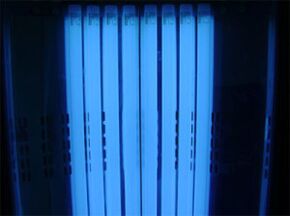Psoriasis has been known to mankind for a long time. It is first mentioned in the Bible, but so far there is no complete understanding of the causes of these skin rashes. Scientists are trying to link this disease with complex disorders of the immune and endocrine systems, and also consider it hereditary. But there was only one absolute success: there was a firm belief that this disease was not a manifestation of an infection of the body. That is, psoriasis is not contagious.
What is psoriasis?
Another name for this disease is scaly lichen. It mainly affects the scalp, the outside of the elbows and the knees, on which dark pink scaly rashes appear. They soon form psoriatic plaques. They have a pronounced white growth, consisting of dense scales, which provoke cracking of the affected areas, accompanied by itching and the formation of leaking wounds. Despite the fact that the causes of rashes are not clear, the mechanism of their occurrence is well understood. With the onset of psoriatic scales, the life cycle of epidermal cells in these and neighboring areas decreases sharply to 4-5 days, as opposed to the normal 28-30 days.
Is psoriasis dangerous?
As its etiology is unclear, but there is convincing evidence that the disease is systemic, affecting not only the skin but also internal organs, it leads to the following disorders in the body:
- appearance of psoriatic-like changes on the lining of the urethra and bladder
- provokes subacute conjunctivitis, sclerosis of the lens and other diseases of the eyes and eyelids
- with exacerbation of the disease there is an increase in the liver with hepatocellular insufficiency and splenomegaly
- enlarged lymph nodes
- there is muscle weakness, their atrophy with a tendency to progressive weight loss
It is possible for a long time to list the complications caused by psoriasis, but from this short list of them it becomes clear that the disease is serious and dangerous. The situation is exacerbated by the fact that currently therapeutic agents are only able to control and suppress the course of the disease, but not to cure it. Psoriasis is permanent, but may be accompanied by long periods of remission.
What can cause exacerbation of the disease or provoke its recurrence?
Despite the fact that the manifestations of psoriasis are unsystematic, there are factors that can provoke the appearance of rashes in different areas of the skin. Therefore, patients should be aware of this and, if possible, beware of their influence. The following causes worsen the course of the disease:
- Overweight. It is noted that among those suffering from psoriasis, the majority of those who have varying degrees of obesity.
- Stress. Many patients notice that their psychological reaction to traumatic situations and circumstances exacerbates the manifestations of the disease.
- Some medications taken by the patient for various reasons can provoke a relapse.
- Hypothermia.
- Damage and scratching of psoriatic plaques. It is noted that in most cases, mechanical irritation of scaly lichen causes its growth and the appearance of new rashes in nearby areas.
- water treatments. In some people, after bathing or swimming in a pond, there is an exacerbation of the disease.
- Sunlight. Doctors believe that moderate exposure to sunlight in psoriasis is beneficial. But there are a number of patients who claim that such baths cause exacerbation of the disease in them. Besides, no matter how long they were in the sun. Therefore, the question of whether it is possible to sunbathe with psoriasis is still not a clear answer. To decide for yourself how useful or harmful the sun's rays are in this case, you need to consider several factors at once: individual tolerance to the sun, skin color and appearance, stage of the disease and its shape.
Ultraviolet for psoriasis: benefit or harm

- Light therapy as one of the treatments for psoriasis:
- PUVA therapy is photochemotherapy, the mechanism of action of which is quite difficult to understand. It is often used in the treatment of exudative and vulgar psoriasis. Very effective for rashes on the scalp, palms and soles. 3-4 sessions of ultraviolet radiation per week are prescribed, until the complete disappearance of psoriatic plaques. On average, 15-25 procedures are required, including local exposure sessions.
- SFT therapy is selective phototherapy. In exudative and vulgar psoriasis, up to 5 procedures per week are prescribed. The radiation dose in the absence of erythema is increased each time. Full course of treatment - 20 - 30 sessions. It has a pronounced therapeutic effect in 85-90% of cases.
- UVB therapy is phototherapy that is comparable in its effectiveness to PUVA therapy. The course of treatment is 20-30 procedures.
Psoriasis and solarium: benefit or harm?
The main difference between tanning in a solarium and in the sun is that under artificial conditions the production of melanin takes place without exposure to dangerous ultraviolet radiation, especially UV-C rays, which are harmful to the skin during sunbathing. Tanning beds do not use this type of radiation. However, in the initial stages of the disease, artificial tanning helps to suppress the development of rashes. Therefore, doctors do not recommend the treatment of psoriasis with a tanning bed, but do not find contraindications for its use as a therapeutic agent.
The effect of radiation in the solarium on the skin
- UV-A rays have a beneficial effect in patients with psoriasis, seborrhea, acne, neurodermatitis.
- UV-B rays start the process of active production of vitamin D3, which reduces the effect of stress on the body, and they are known to provoke psoriatic rashes.
Thus, visiting the solarium can not have a negative impact on the course of the disease and may to some extent muffle it. But then why are there people who are only harmed by tanning sessions? The answer is that the combination and power of the lamps in the solariums are different. When choosing a salon, you should ask about their spectral composition, one of the most important features. The lamps are designed with different combinations of UV-A and UV-B radiation. For example, those with UV-B 1% or less are classic, and those with UV-B over 1% are professional.

It is also important to have a reflector. If it is not present, then the radiation hits the skin weakened, and if there is, then concentrated. The reflector can be located both inside and outside the lamp. Whether or not there is a reflective layer in the luminaire, you can tell if you look at the lamp through the light. If so, then the efficiency of its radiation is 10% higher than that of conventional.
Therefore, in order for the treatment of psoriasis with a tanning bed to be useful and not harmful, it is necessary to choose the right tanning studio with the right combination of UV radiation. Excessive is always harmful to the skin and leads to the formation of tumors and other problems with it. The ratio of UV-A and UV-B rays is very important for patients with psoriasis. The best combination here would be the following combination: UV-B waves with a length of 311 nm. and UV-A waves 300-400 nm. This ratio of ultraviolet radiation has a Daavlin photo booth, which gives light with a narrow spectrum nbUVB 311nm. Those who visit it notice a sharp improvement in their condition. The course of treatment is 20-30 sessions.
Therefore, the question: does the solarium help with psoriasis can be answered with confidence - yes. But it is important not to choose a meaningless studio near the place of residence, but to be interested in the spectral characteristics of the emitting lamps in it. It is important to know that the vertical tanning method is preferable to the horizontal one. The time spent in the cabin should not exceed 5-6 minutes, and sessions should be alternated every other day. UV rays in moderate doses help strengthen the immune system. What is extremely necessary for a patient with psoriasis.























